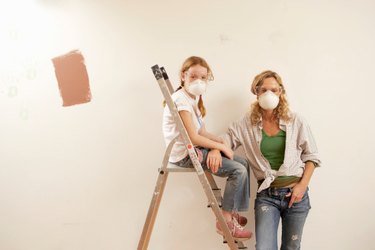Things You'll Need
Plastic drop cloths
Tacks
Goggles
Dust mask
Wallpaper scraper or wide putty knife
Palm sander
Precut 40- to 80-grit sandpaper
Sanding block
Rags
Spray bottle
Garbage bag

While many faux finishes merely create the illusion of texture, some actually build the surface up. A tissue paper wall treatment leaves your wall with a three-dimensional, wrinkled pattern. Unlike wallpaper, which uses a water-soluble adhesive, the acrylic medium securing a tissue paper faux finish is permanent. The removal of this surface requires a lot of elbow grease and creates a significant amount of dust. Investing in an electric sander will make the job go a lot faster.
Step 1
Cover the floors with disposable plastic drop cloths. Tack up a plastic sheet in front of the door to keep dust out of the rest of your house. Insert the tacks into the top edge of the door frame, where they will not leave visible holes.
Video of the Day
Step 2
Wear goggles while sanding the wall. Place a dust mask over your mouth and nose. Squeeze the mask's metal strips along the side of your nose to ensure a good fit.
Step 3
Scrape off as much of the tissue paper as possible with a wallpaper scraper or a wide putty knife. Take care not to gouge the walls.
Step 4
Sand the walls with a palm sander. Use coarse-grit sandpaper. Run the sander in a horizontal direction, then sand in a vertical direction. Touch the wall from time to time to check on your progress. Change the sandpaper frequently. The grit wears down quickly, making the sander less effective. Sand any areas that the palm sander can't reach with a sanding block.
Step 5
Wipe down the walls with damp ramps. Rinse the rags frequently with clean water. Mist the room with a spray bottle filled with water to help settle the dust.
Step 6
Carefully gather up the edges of the plastic drop cloths to contain the dust. Be careful not to stir up dust unnecessarily. Place the drop cloths in a garbage bag.
Tip
Place a fan in a window to help vent the room. Position the fan to blow outward.
Warning
Do not sand any painted surfaces that may contain lead. Do a lead test if you are unsure.
Video of the Day